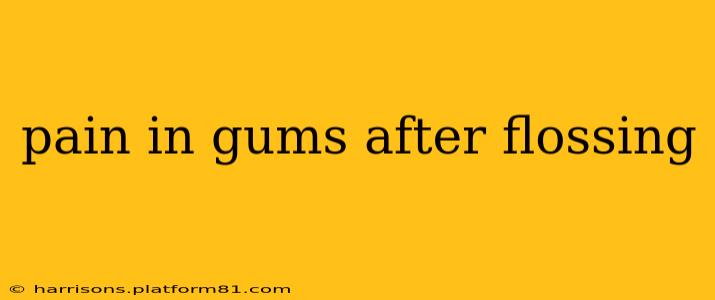Flossing is a crucial part of maintaining good oral hygiene, yet many people experience gum pain afterward. This isn't necessarily a sign that you're doing something wrong; however, understanding the causes can help you prevent future discomfort and ensure you're flossing effectively. This comprehensive guide explores the reasons behind post-flossing gum pain, offering practical solutions and advice.
Why Do My Gums Hurt After Flossing?
Gum pain after flossing usually indicates some underlying issue, and it's not always about the technique. Several factors can contribute to this discomfort:
-
Gingivitis: This is the early stage of gum disease, characterized by inflamed and bleeding gums. Flossing, while necessary, can exacerbate the inflammation and cause pain if gingivitis is present. The plaque and bacteria trapped between your teeth are the primary culprits, and flossing disrupts this, causing temporary sensitivity.
-
Aggressive Flossing: Using too much force while flossing can injure the gums, leading to soreness and bleeding. The goal is gentle but thorough cleaning, not forceful scraping.
-
Improper Flossing Technique: Incorrect flossing technique can damage gum tissue. Instead of carefully guiding the floss between teeth, improper technique can cause abrasion or cuts.
-
Gum Recession: As gums recede, the roots of teeth become exposed, making them more sensitive and prone to pain during flossing.
-
Newly Erupted Wisdom Teeth: Wisdom teeth, especially those impacted or partially erupted, can create tight spaces, making flossing difficult and potentially causing discomfort.
-
Dry Mouth: Lack of saliva can make your gums more susceptible to irritation and pain. Dry mouth can also increase bacterial growth, leading to inflammation.
What Should I Do If My Gums Hurt After Flossing?
If you experience pain after flossing, don't immediately stop. Instead, focus on improving your technique and addressing any underlying issues.
-
Adjust Your Technique: Use gentle, C-shaped motions around each tooth, avoiding snapping the floss. Guide the floss gently between teeth and along the gum line.
-
Use Therapeutic Mouthwash: A therapeutic mouthwash can help reduce inflammation and soothe irritated gums. Look for mouthwashes containing ingredients like chlorhexidine or cetylpyridinium chloride.
-
Consider a Water Flosser: A water flosser (oral irrigator) can provide a gentler alternative to traditional floss, especially if you have sensitive gums. The pulsating water stream cleans between teeth without the potential abrasiveness of floss.
-
See Your Dentist: Persistent gum pain or bleeding after flossing warrants a visit to your dentist. They can diagnose any underlying conditions like gingivitis or gum disease and recommend appropriate treatment.
How Can I Prevent Gum Pain After Flossing?
Preventing gum pain comes down to adopting the right flossing habits and maintaining good oral hygiene:
-
Floss Gently: The key is to be thorough but gentle. Avoid snapping the floss against your gums.
-
Use the Right Floss: Experiment with different types of floss to find one that's comfortable for your gums. Waxed floss often slides more easily.
-
Floss Regularly: Daily flossing is crucial for preventing plaque buildup and gum disease. Make it a habit.
-
Maintain Good Oral Hygiene: Brush your teeth twice a day with fluoride toothpaste and use an antimicrobial mouthwash.
-
Visit Your Dentist Regularly: Regular dental checkups are essential for early detection and treatment of gum problems.
Is Bleeding Gums After Flossing Normal?
Some slight bleeding is common, particularly if you haven't flossed regularly. However, persistent or heavy bleeding indicates a problem. It's crucial to consult your dentist to rule out conditions like gingivitis or periodontitis.
How Often Should I Floss?
You should floss at least once a day, preferably before brushing your teeth in the evening.
Can I Use Mouthwash Instead of Flossing?
Mouthwash is a supplementary tool, not a replacement for flossing. It helps reduce bacteria but doesn't physically remove plaque from between teeth, where flossing is essential.
By understanding the causes of post-flossing gum pain and adopting proper flossing techniques, you can significantly reduce discomfort and maintain healthy gums. Remember, consistent oral hygiene is key to a healthy and happy smile.
